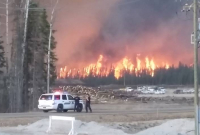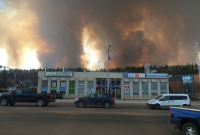Support strong Canadian climate journalism for 2025
A harsh reminder of the perils still at play in the Alberta wildfires emerged Monday afternoon as employees at work camps north of Fort McMurray were moved out as part of a precautionary evacuation.
High winds spurred the quickly spreading wildfire as tinder-dry conditions persist in the region.
"Heavy smoke ... does make it unsafe to fly in some spots, but we are able to still work the flanks and hope to pinch it off," said Alberta wildfire manager Chad Morrison.
"When you have this kind of extreme fire behaviour it doesn't matter what tankers you put in front of it, it doesn't matter how many helicopters, Mother Nature is going to want to continue to move that fire forward."
The fire itself was about 20 kilometres away from the work camps as of early Monday evening, but around 10 p.m. the Rural Municipality of Wood Buffalo issued a second alert saying that the evacuation zone now stretches 50 kilometres north of Fort McMurray to just south of Fort MacKay.
Initially, about 4,000 workers stayed at 12 camps in the area, including many at Suncor and Syncrude, but the new alert instructed all camps and production facilities to evacuate immediately, and for all evacuees to head south on Highway 63 "if possible."
Officials said another 500 to 600 people in four small camps along Aostra Road were under a mandatory evacuation.
Scott Long of the Alberta Management Agency said there was no panic and the evacuations were being done in an orderly manner.
"We're very hopeful that we'll be able to hold the line, but if not, we want to make sure that people's lives are taken care of."
"The big factor obviously for the folks on site is that they will see very, very, heavy, dark smoke," said Morrison.
The Rural Municipality of Wood Buffalo said the fire was moving 30 to 40 metres per minute and was expected to burn six kilometres in two hours.
"This controlled, precautionary evacuation is an example why it is not safe to be in the Regional Municipality of Wood Buffalo at this time," the municipality said late Monday afternoon in a news release.
Syncrude Canada tweeted that buses were transporting workers to a safe location as part of its emergency plan.
"The facilities are not at risk," said Sneh Seetal of Suncor Energy. "However, we felt it was important to take these steps in the interest of putting people first."
"We are just responding to the northern edge of the fire. The wind is changing towards the north," said Kirk Duffee, president of oil and gasfield services for Clean Harbours, a company that operates a work camp at Ruth Lake.
"We are in the process of relocating folks out of harm's way and working with the emergency operations command to evacuate facilities as required."
The entire population of Fort McMurray, more than 80,000 residents, are now entering their third week away from home. Many of the work camps were used to house evacuated residents who fled north when fire broke through into the city the afternoon of May 3.
Those residents were taken to points south, including Edmonton and Calgary, several days ago and workers were moved back in to begin ramping up oilsands production again.
About 2,400 structures were destroyed in Fort McMurray, but essential infrastructure, including the hospital, water treatment plant and the airport, remain intact.
Crews continued to battle hot spots on the edge of the city Monday while the fire still raged out of control deeper in the forest.
"The original fire does provide a very good fire guard for firefighters to work from," said Morrison. "They have done a very, very good job of holding the line there and with the extra fire guard I believe that they will be quite successful."
Earlier Monday, officials warned the air quality in the Fort McMurray area was dangerously poor.
Alberta Premier Rachel Notley said the air quality health index is normally one to 10, with 10 being the worst, but the reading this morning was at 38.
Notley said the conditions were hampering efforts to get residents back to their homes.
"Alberta Health Services has recommended that members of the public who had been previously arranging to return to the area under various requests not return until those conditions improve," Notley said. "This is something that could potentially delay recovery work and a return to the community."
Karen Grimsrud, Alberta's chief medical officer of health, said they expect the air quality readings to remain in the extreme range for the next couple of days.
She said workers in the area should be wearing respirators.
The Canadian Press.






Comments